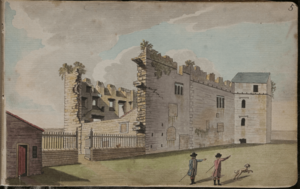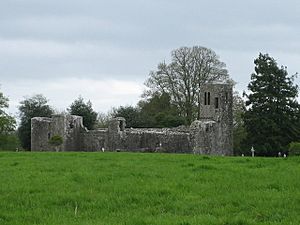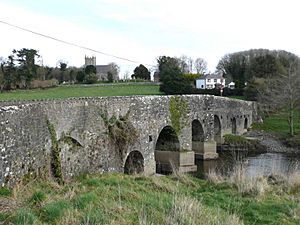John Cruys facts for kids
Sir John Cruys (died 1407) was an important Irish leader. He was a military commander (a leader in the army), a diplomat (someone who represents their country), and a judge (someone who makes legal decisions). He lived in the late 1300s and early 1400s. Sir John owned a lot of land in County Dublin and County Meath. He built Merrion Castle near Dublin City in the 1360s. When he married Matilda Verdon, he also gained lands in County Louth. He was part of the Irish Parliament and the King's Council. People thought he was a good public servant. He was also a strong businessman who fought for ten years to make sure his wife received her inheritance (what she was supposed to get after someone died).
Contents
Early Life and Family
Sir John Cruys was the son of Simon Cruys. Simon was an official who handled lands for the King in County Dublin. The Cruys family came from England with King Henry II of England in the late 1100s. Their ancestors were from Normandy in France. They owned many lands, including Cruisetown in County Meath and Naul.
Merrion Castle and Other Lands

In 1366, Sir John Cruys received lands called Thorncastle. This area is now Mount Merrion and Booterstown. He also got the fisheries (fishing areas) connected to these lands. Sir John built Merrion Castle on his lands at Thorncastle. This castle became his main home.
Sometimes, Irish clans from County Wicklow attacked his lands. In the early 1390s, he lost control of his lands there for a short time. He also inherited family lands at Stillorgan and Naul. He gained more lands in Dublin, Meath, and Louth through his wife, Matilda Verdon.
Most of his lands were held directly from the English Crown (the King of England). In 1391, he did not have to pay rent to the King for his lands at Thorncastle. This was because Irish clans often burned and destroyed them. Official records noted how often his lands were "burned and destroyed."
Sir John's Career
In 1376, Sir John went to England with Maurice FitzGerald, 4th Earl of Kildare. They had important diplomatic work to do. They reported to the King about the situation in Ireland. Sir John was paid £20 for his travel costs. This money may also have helped him because the O'Byrne family had damaged his lands at Booterstown while he was away.
Sir John was a close friend of Sir William de Windsor, who was in charge of Ireland from 1369 to 1376. After Windsor was removed from his position, Sir John was out of favor for a short time. But this did not last long.
In 1380, he was called to the Parliament of Ireland meeting in Baltinglass. In 1382, he became a Guardian of the Peace for Dublin and Meath. This meant he helped keep order. He also worked as a judge who traveled around in 1385. That same year, he led an army against the O'Toole clan. He was badly hurt and received money from the King for his injuries.
In 1394, he was called to the Great Council of Ireland. In 1395, he was paid £20 for providing men and weapons for wars against Irish groups. He was made a knight before 1399. In 1404, he helped gather important people and ordinary citizens of Dublin when needed, especially if the O'Toole and O'Byrne clans attacked.
In 1406, he received lands at Rathwire, County Westmeath. He also gained the right to choose the local parish priest for the church there. He also got other lands at Rathmore, County Meath. He died the next year, in 1407.
An official investigation in 1408 showed how much land he owned. He had properties at Merrion, Thorncastle, Rathmore, Donaghpatrick, Clonmore, Kells, Naul, Duleek, and Dundalk.
Family Life
Sir John and his wife, Matilda, had at least three children. Their son, Sir Thomas Cruys (died 1424), inherited most of his father's lands. These lands then went to Thomas's own son.
One of Sir John's daughters, Maria, married Stephen Derpatrick. They had a daughter named Katherine. Another daughter married James Fitzwilliam, an important judge for money matters. They had a son named Phillip. Phillip Fitzwilliam later inherited Merrion Castle and most of the Cruys lands.
Some lands, like Rathmore and Naul, went to another part of the Cruys family. They held these lands until they were taken by Oliver Cromwell much later. Stillorgan was returned to the Cruys family after a younger Stephen Derpatrick was declared an outlaw (someone outside the law) in 1439. The Fitzwilliam family eventually owned much of Dublin south of the River Liffey.
Sir Thomas Cruys received a full pardon (forgiveness) in 1414 for all debts and unpaid rents owed to the King. He was allowed to visit England in 1421. He died in 1424, leaving two young sons, Edward and Christopher.
Sir John's widow, Matilda, was still alive in 1415. She used her family's right to choose the priest for the local church at Clonmore.
See also
- Thomas Fitz-Christopher Plunket



